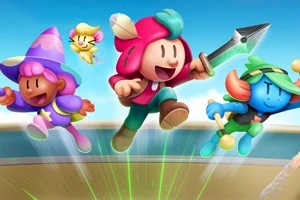Feature: From You To Mii #1

Posted 20 May 2008 at 16:09 by Tom Phillips

Nintendo’s character building. From you to mii.
Written by Mark Lee
Although it may not be instantly apparent when sliding around corners, defeating Koopas or raising a virtual dog, Nintendo have always had an infatuation with players having something to relate to. But where did this obsession stem from and where has it led Nintendo? Read on to find out in part one of our two part investigation, as we travel back in time...
Gaming on paper
Go back to the very creation of Nintendo and you’re looking at a business based on entertaining the masses through social gaming – which astoundingly is exactly what Nintendo still do today.
Fusajiro Yamauchi founded Nintendo Koppai in 1889 as a producer and distributor of Hanafuda cards and although pictures of Japanese blossoms and geese probably don’t mean anything to the average joe now, in 1889 this imagery was extremely relevant to the masses.
It could be argued that the core idea behind social gaming comes from a vast amount of people relating to stringent rules and ideas. It’s not hard to see that card games were one of the major contributors to early social gaming sessions and that the fundamental ideas of play and competition (situated around a rule-set) is something videogames also adhere to. Throw in relevant characters (using Japanese imagery) and you have a run-away success on your hands. As Fusajiro certainly encountered!

42 All-Time Classics includes Koi Koi – Hanafuda in all but name.
In 1959, the Yamauchi’s young business prodigy Hiroshi moved away from cherry blossoms and cut a shrewd deal with Walt Disney to show Mickey Mouse and Popeye on Hanafuda cards. Although the tactic was used to drive consumer awareness of the house of mouse in the east it was also a means to increase Hanafuda sales. And it worked, immensely.
Historically, the approaches taken by both Fusajiro and Hiroshi Yamauchi tell us that they both knew that a strong character (relative to the world around the consumer) was a tool – a tool which had the ability to assist and drive sales upwards. In today’s society this cross-over effect can be seen in most products.
Gaming goes electronic...
Shigeru Miyamoto openly admits that Mario was a carpenter (and later a plumber) because, y’know, that’s what normal, hard-working people do. Even characters such as Gunpei Yokoi’s Samus and the much-loved Link have human elements weaved into their psyche. Elements of believability if you will. For (primarily) mute creations this is no small feat. Being comparative to humankind, whether it is by their own actions or the actions of others, means these characters hold water with people all over the world. Say what you will, the staple characters Nintendo rely on so heavily transcend boundaries the world over – solely because they share vast human characteristics.

Jumpman (aka Mario), doing what carpenters do best. (Pratting about with a hammer? –Ed)
Moving into the NES era saw Nintendo adding more creations to their ever increasing roster of characters. Creations that would go on to sit in the homes of millions.
The Jumpman idea saw massive expansion with crucial development on the “save Pauline” idea and central character. The idea of exploration was also taken to a whole new level with the release of Zelda on the NES. Yet, crucially these titles launched with a hero no-one would fear nor become alienated to. Launching new titles we saw plumbers, a young boy in a green garb, a princess needing rescuing from a dragon-like creature, a young mystical greek warrior, a humorous dog needing help via an orange ‘zapper’. The list is endless.
Most of the casual, welcoming characters were from Miyamoto’s head and even when referencing one (seemingly peripheral) character we can show the simple, human thought processes behind his design choices. Chain Chomp first appeared in Super Mario Bros 3 on the NES - striking fear in players the world over. Miyamoto has actually stated that a journey past a gate when he was younger struck fear into him. Miyamoto stated that a large dog chased him past the gate yet was constantly yanked back by it’s chain.
It doesn’t take a genius to see the parallels to Chain Chomp. But it does take a genius to interpret this idea into a visual representation all the while evoking a simulated, similar emotional response from the player. (Note how Chain Chomp emits a ‘bark’ noise in later titles.)

Chain Chomp – AKA Woofster the mauler dog.
To gather further evidence of Miyamoto’s real-world design choices brings us to the gardens situated around Nintendo’s old Kyoto offices. A vast statue of a fox stands in the park looking up to the Heavens. This is well known to be the inspiration for the character of Starfox.
The Japanese love for animals continues throughout many companies (Sonic anyone?) and is even shown in the initial 1989 reveal of Pilotwings. Simply entitled 'Dragonfly', it showed off the upcoming Super NES scaling and rotation effects. (This was later to become the system's Mode7 effect.) Again, all originally based on an insects ability to fly.
Fast forward many years and Miyamoto takes up gardening. He then goes on to create Pikmin. He get’s a puppy, and creates Nintendogs. He grows older and wishes to share his hobby with his wife... You can see where this is going, right?

A 1989 shot of ‘Dragonfly’ – The precursor to ‘Pilotwings’
And so it can be seen that, even from the early days, Nintendo (and specifically, Miyamoto) were launching franchises using characters with rational, believable elements innately programmed into them. The fact that they frequently built titles on solid characters before adding in little touches (like Chain Chomp’s) in minor areas to gain an emotional hold on players would further enhance the emotional integrity of all they would produce.
And they never looked back.
Join us next week for part 2!






















